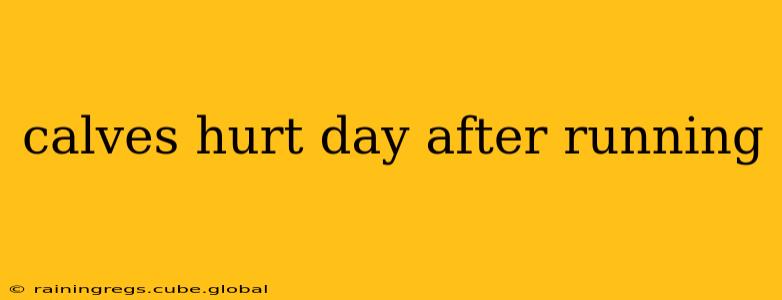Running is a fantastic way to improve cardiovascular health and build strength, but it can also lead to some unwelcome aches and pains. One common complaint is calf pain the day after a run. This delayed-onset muscle soreness (DOMS) is often more than just a minor inconvenience; it can significantly impact your training schedule and overall well-being. This comprehensive guide delves into the causes of calf pain after running, effective treatment strategies, and crucial preventative measures to keep you running strong.
Why Do My Calves Hurt After Running?
The primary reason your calves hurt the day after running is delayed-onset muscle soreness (DOMS). This isn't immediate pain; instead, it typically appears 12-24 hours after strenuous activity, peaking at 24-72 hours. DOMS is caused by microscopic tears in your muscle fibers resulting from eccentric contractions—actions where your muscles lengthen while contracting, such as during the lowering phase of a calf raise or the impact phase of your foot hitting the ground while running. These tiny tears trigger an inflammatory response, leading to the familiar soreness and stiffness.
Several factors can influence the severity of your DOMS:
- Intensity and duration of your run: Longer runs and those involving more intense effort are more likely to cause significant muscle damage and subsequent soreness.
- Running surface: Running on uneven terrain or hard surfaces places greater stress on your calves than running on softer surfaces like trails.
- Previous running experience: If you're new to running or haven't run in a while, your muscles are less adapted to the demands of running, increasing your risk of DOMS.
- Improper form: Poor running form can put excessive strain on your calf muscles, leading to increased soreness.
- Dehydration: Insufficient hydration can impair muscle function and increase susceptibility to injury.
- Inadequate warm-up and cool-down: Skipping warm-ups and cool-downs reduces blood flow to muscles, making them more prone to damage.
What Can I Do About Calf Pain After Running?
Fortunately, several strategies can help alleviate calf pain after running.
Rest and Recovery:
This is arguably the most important factor. Allow your muscles sufficient time to repair themselves. Avoid strenuous activity that exacerbates the pain.
Ice and Elevation:
Applying ice packs to your calves for 15-20 minutes at a time, several times a day, can reduce inflammation and pain. Elevating your legs above your heart can also help reduce swelling.
Gentle Stretching and Foam Rolling:
While vigorous stretching should be avoided while your calves are acutely sore, gentle stretching and foam rolling can improve blood flow and reduce muscle stiffness. Focus on stretches that target the gastrocnemius and soleus muscles, the two main muscles in your calf.
Over-the-Counter Pain Relief:
Nonsteroidal anti-inflammatory drugs (NSAIDs) like ibuprofen or naproxen can help reduce pain and inflammation. Always follow the recommended dosage.
Massage:
Massage therapy can improve blood flow, reduce muscle tension, and promote healing. Consider seeking professional massage if your pain is severe or persistent.
How Can I Prevent Calf Pain After Running?
Prevention is always better than cure. Here's how to minimize your risk of calf pain:
Proper Warm-up and Cool-down:
Always start your run with a thorough warm-up that includes dynamic stretches like leg swings and high knees. End your run with static stretches, holding each stretch for 20-30 seconds.
Gradual Increase in Running Intensity and Duration:
Avoid suddenly increasing your mileage or intensity. Gradually increase your running volume by no more than 10% per week.
Appropriate Footwear:
Invest in running shoes that provide adequate support and cushioning for your feet and ankles. Consider consulting a specialist to ensure you're choosing the right shoes for your foot type and running style.
Hydration and Nutrition:
Staying properly hydrated and consuming a balanced diet rich in protein and carbohydrates supports muscle recovery and reduces the risk of injury.
Strength Training:
Incorporating strength training exercises, particularly those targeting the calf muscles, can improve muscle strength and endurance, reducing the risk of injury.
What If My Calf Pain Persists?
If your calf pain persists for more than a week or is accompanied by other symptoms such as swelling, redness, or limited range of motion, consult a doctor or physical therapist. Persistent calf pain could indicate a more serious condition requiring professional medical attention.
This information is for general knowledge and informational purposes only, and does not constitute medical advice. It is essential to consult with a qualified healthcare professional for any health concerns or before making any decisions related to your health or treatment.
